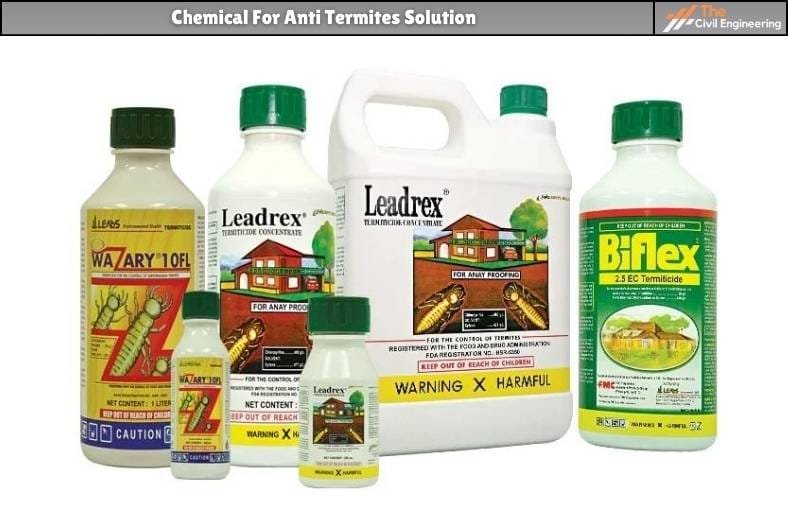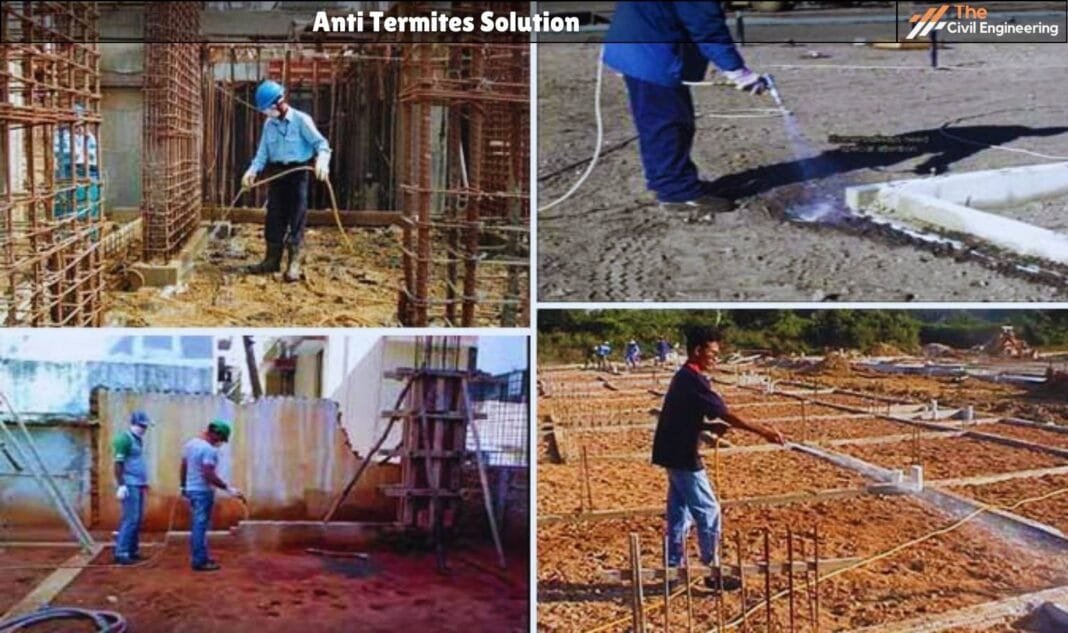The anti-termite solution may be defined as a chemical process to give the building chemical protection against underground termites before and after the completion of the construction work.
The anti termite solution used for anti-termite treatment in buildings as per Indian Standards (IS 6313 Part-3) is: Chlorpyrifos 20 EC. Lindane 20 EC.
1. Chemical For Anti Termites Solution
The chemicals utilized for anti-termite treatment in buildings as per Indian Standards are :
1. Chlorpyrifos 20 EC
2. Lindane 20 EC
These two chemicals are utilized in water emulsion for the treatment of soil in order to save a building from termite attacks. For the treatment of wood, oil, or kerosene-based solution of these chemicals with 1.0% concentration is utilized.

3. Types of Anti-Termite Treatment
There are two main types of anti-termite treatment as given below;
1. Pre-Construction Anti-Termite Treatment
2. Post Construction Anti Termite Treatment
3. Site Preparation
4. Soil Treatment
5. Physical Structural4de Barriers
3.1. Pre-Construction Anti-Termite Treatment
The sides and the bottom surface of the foundation ditches are treated with an anti-termite chemical at the rate of 5 Lit per square meter of surface area to a height of about 30cm for the excavation prepared for the foundation.
The earth’s surface is cleaned from wood and any other garbage particles for flooring and to the needed elevation, the whole surface should be even.
At a certain of 15 cm holes of 30 cm depth are prepared and by putting water to the chemical an emulsion of the exact concentration shall be prepared.
By flowing jars, this emulsion shall flow in the holes and by utilizing pressure pumps and sprayers, sprayed on the surface.
Through the holes, the chemical is permitted to get wet fully.
Benefits of Pre-Construction Anti Termite Treatment:
There are the following advantages of this treatment as given below;
a. As contrasted to post-construction treatment, the steps contains in pre-construction treatment are fewer and also need less cost.
b. In the case of pre-construction anti-termite treatment, the number of obstacles is low.
c. Pre-construction treatment is needed to separate the termite infestation from its root.
3.2. Post Construction Anti Termite Treatment
After finishing the construction of the building, this treatment is done and usually has of reusing termiticides to the soil around the foundation.
For termite control, it also uses the floors of rooms by preparing holes under floors and filling them with chemicals. For buildings that are infected by termites, this treatment is performed.
The soil around and below the building is reacted with chemical emulsion in case of a serious attack.
With oil or kerosene-based chemical emulsion, the woodwork which is poorly damaged by termites may be changed by another timber brushed in this treatment.
3.3. Site Preparation
This operation consists of the removal of stumps, roots, logs, waste wood and other
fibrous matter from the soil at the construction site. This is essential since the termites
thrive on these materials. If termite mounds are detected, these should be destructed
by use of an insecticide solution, consisting of any one of the following chemicals :
| Chemical | Concentration by weight |
| (i) DDT | 5% |
| (ii) BHC | 0.5% |
| (iii) Aldrin | 0.25% |
| (iv) Heptachlor | 0.25% |
| (v) Chlordane | 0.5% |
Four liters of the above emulsion in water are required per cubic meter of the volume of the mound. Holes are made in the mound at several places by use of a crowbar and the insecticide emulsion is poured into these holes.
3.4. Soil Treatment
The best and only reliable method to protect buildings against termites is to apply a chemical treatment to the soil at the time of construction of the building. This should be done in such a way that a complete chemical barrier is created between the ground from where the termites come and damage the woodwork in the building. An insecticide
the solution consists of any one of the following chemicals in water emulsion:
| Chemical | Concentration by weight |
| (i) Aldrin | 0.5% |
| (ii) Heptachlor | 0.5% |
| (iii) Chlordane | 1% |
Out of the above chemicals and several other chemicals, Aldrex 30 E.C. has proved to be the most effective. It has the following advantages :
(i) It is highly toxic to termites.
(ii) It can easily be applied after dilution with water.
(iii) It is insoluble in water. In other words, this chemical will not
dissolve in b-soil water and disappear quickly from the site.
(iv) It is effective even many years after application.
One part of Aldrex 30 E.C. is diluted with 59 parts of water. This provides an emulsion of 0.5% containing aldrin.
The emulsion should be applied evenly either with a watering can or sprayer at the following stages:
Stage 1
In foundation pits, treat the bottom and sides up to a height of about 30 cm. The emulsion required is at the rate of 5 liters per square meter.
Stage 2
The refill earth on both sides of all built-up walls, for a width of 30 cm and depth of 45 cm approximately. The emulsion required is at the rate of 5 liters per square meter.
Stage 3
Before laying the floor, the entire leveled surface is to be treated at the rate of 5 liters of emulsion per square meter.
When used as recommended above, approximately 200 ml of Aldrex 30 E.C. would treat one square meter of the covered area.
3.5. Physical Structural Barriers
Continuous impenetrable physical structural barriers may be provided continuously at the plinth level to prevent entry to termites through walls.
These barriers may be in the form of a concrete layer or metal layer. The cement concrete layer may be 5 to 1.5 cm thick. It is preferable to keep the layer projecting about 5 to 7.5 cm internally and externally.
A metal barrier may consist of non-corrodible sheets of copper or galvanized iron of 8mm thick. These sheets are likely to be damaged; in that case, they become ineffective against termite movement.
| Read More: Air Conditioning System |
4. Advantages of Ant Termites Solution
The advantages of Anti termites are as follows:
a. It increases durability.
b. It gives instant safety to the structure from termites, rodents, and pests.
c. It reduces the chance of gaps forming in the safety barrier, permitting termites to go in the home.
d. Liquid termiticides are comparatively cheap when contrasted to other forms of termite control.
| Read More: Sanitary Fittings |
5. Disadvantages of Anti Termites Solution
The disadvantages of Anti termites are as follows:
a. Anti-Termite treatment can result in water impure in places near waterways or wetlands.
b. Making a hole into places that provide evidence of termite entry, or concrete may be important, which can decrease the strength of the member or structure.
Read Also: Dowel Bars
Read Also: Systems of Plumbing

